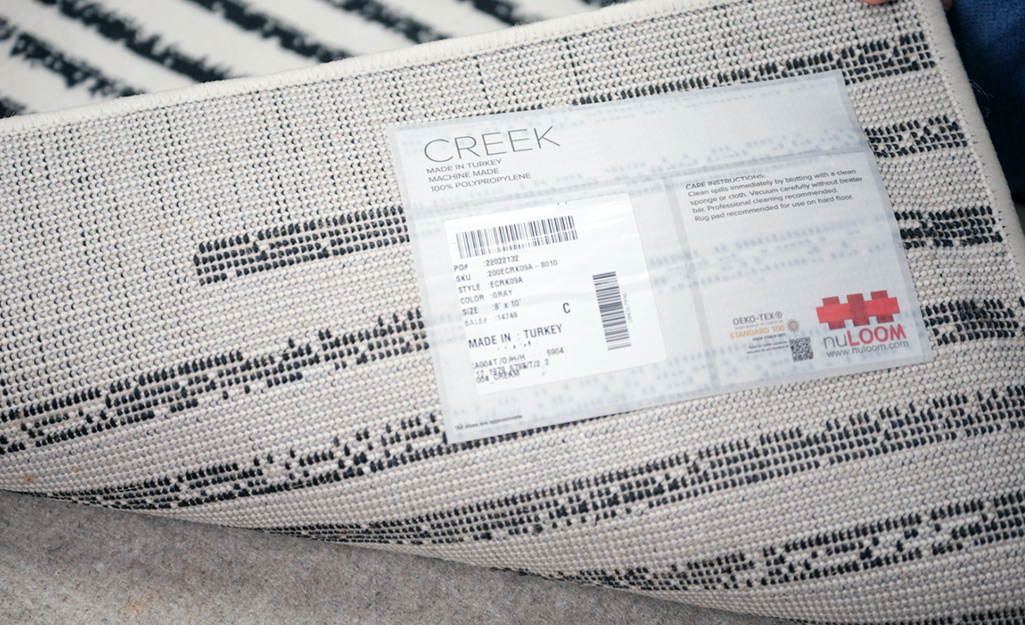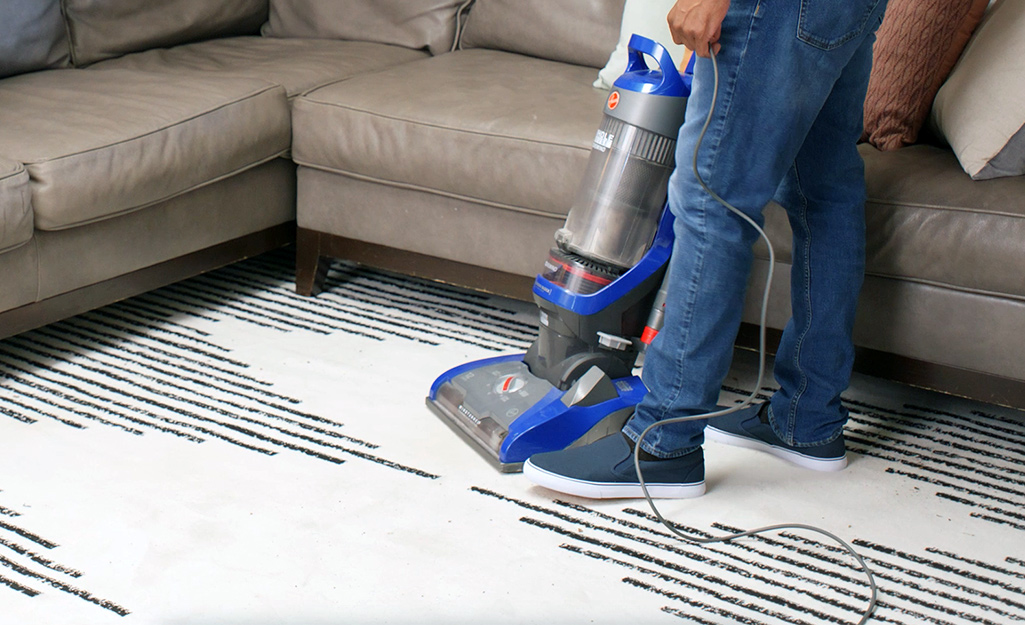Carpet and Rug Cleaning: Regular Care Makes Your Carpets Last.
Vacuum Effectively on a Weekly Basis
In our how to vacuum post, we go over how to get the most out of your vacuuming sessions. For example, did you know that you should dust before you vacuum?
And that you should work backwards, making multiple passes over the same area to ensure you pick everything up? In other words, don’t rush the task no matter how much you dislike it. Also, don’t forget to move furniture to vacuum underneath it on a regular basis, if not weekly. We also recommend immediately treating stains and offer tips on how to do exactly that in the post.
Hire a Professional Carpet Cleaner to Deep Clean or DIY
Carpet manufacturers recommend deep cleaning every 12 to 18 months. Hot water extraction is the most common method used. You can hire a professional, or you can purchase or rent a cleaner from your local home improvement store to DIY.
In addition to saving you time and effort, hiring a professional has many benefits. Hot water extraction involves spraying hot water with cleaning solution onto your carpet.
The professional then uses a powerful vacuum to suck up the liquid and leave your carpet clean. Most companies use truck-mounted machines as they offer the most suction and therefore the best results. You won’t get such power from the portable machines available for sale or rent to consumers.
How to Clean a Rug
Know When It’s Time to Clean

Regular vacuuming is great for weekly maintenance, but dust and dirt can settle deep into the fibers. This can be especially hard to see in colorful, patterned rugs. To determine when it’s time to clean your rug, it’s best to do examine it closely.
- Pick up a corner of the rug and drop it. If it emits a cloud of dust, it’s time for a deep clean.
- Do some areas look darker or uneven in color? If so, it’s cleaning time.
- Gently rub over a high-traffic spot in the rug. If it feels rough and matted down or has residue, the rug is holding in dirt.
- Take a sniff. If the rug doesn’t smell clean, it isn’t clean.
Check Rug Label

Some rugs may be easy to clean in your washer and dryer. Small cotton rugs and washable rugs fit into this category. For other rugs, it’s best to see if they are tagged with cleaning instructions. Unless specific guidelines are attached, most rugs can be hand cleaned or you can use a machine.
Tip: If you have an especially fragile antique or vintage rug, consult a professional rug cleaner.
Gather Your Tools

Cleaning a rug can be time consuming. With the right supplies, you can move the job along quicker. You’ll need a vacuum cleaner and a rug beater or broom.
Get carpet stain remover and a rug shampoo. A 5-gallon bucket is just the right size for mixing the cleaner. Use a garden hose with spray nozzle for rinsing.
Other cleaning supplies include white towels, large sponges, a soft bristle brush and a tarp to use as a work surface. For drying, get a squeegee to push out excess water. A box fan is a handy appliance that will help the rug dry even faster.
Tip: Plan to clean your rug on a sunny day. The fresh air, heat and sunshine will speed up the drying process. If an outside area is not available, use an indoor area that moisture will not damage such as a kitchen or garage floor.
Remove Dirt & Dust

Vacuum the rug in place. Empty the filter on the vacuum cleaner to make sure you capture as much dirt and dust as possible. After a thorough vacuuming, take the rug outside.
Hang it over a fence, outdoor table, sawhorses or sturdy chairs. Use a rug beater or broom to beat the rug. This will release and loosen deep down dirt and dust. If you have allergies, wear a dust mask. Don’t forget to shake out the rug pad too.
Could your area rug use a deep clean? Probably. Learn how to clean a rug and bring your floor coverings back to life in less than an hour. Area rugs may bring a room together, but they also take a beating, from foot traffic to pets to spills.
After a while, vacuuming just isn’t enough to get it truly clean—and that’s when a deep clean is in order.
What is the best way to clean my rug?
Regular cleaning with a vacuum cleaner and prompt spot-cleaning can go a long way when it comes to helping area rugs look great and last for years, but every rug needs a little bit more attention from time to time.
The type of rug you own will determine how you maintain and clean it, says Jasmin Cleaning Services, owner of Carpet Care of the Houston. “Natural fiber rugs have to be treated differently than a synthetic rug.
No question,” he says. Jasmin notes that wool rugs should only be cleaned with a cold water process, which protects the fibers from damage or distortion. “You can be much more aggressive when cleaning synthetic rugs, as they can handle hot water and stronger cleaning solutions,” he continues.
What tools and supplies do I need to clean an area rug at home?
Here’s exactly what you’ll need to have on hand to complete a successful DIY area rug cleaning:
- Rug shampoo (or mild dish soap)
- Bucket
- Soft-bristle brush or sponge
- Water
- Rubber gloves
- Garden hose
- Wet-dry vacuum
How do you deep-clean an interior rug?
For cleaning your specific area rug, it’s always best to check the manufacturers guidelines, often found on a care label on the underside of a rug. Otherwise the process is quite similar to carpet cleaning. After a spot test (more on that below), here’s the best way to clean wool rugs, shag rugs, and even mats.
Step 1: Clear furniture and objects off of the rug (and take it outside, if possible)
According to Jasmin Cleaning Services, rugs should be taken out of the home for proper cleaning. “We use a lot of water while cleaning to assure proper soil removal,” he says. “They also have to be dried quickly and properly to assure colors do not fade or run.” Make sure you tackle this DIY project on a sunny day so rain doesn’t threaten the cleaning process.
To avoid making a bigger mess, place your rug on a tarp, drop cloth, or large piece of plastic instead of directly onto the ground.
Step 2: Remove dirt and debris
“A great way to prevent stains from happening in the first place is to vacuum your rugs weekly,” says Anjuli Bernstein, senior designer on the Patterson Flynn design team. “Make sure to use a suction only vacuum, rather than a rotating brush. This is highly effective for removing dirt particles before they sink in, while also remaining gentle on the rug’s fibers.” Thoroughly vacuum the rug on both sides.
You want to make sure every last bit of debris is gone. Using a vacuum cleaner with a beater bar is most effective for this task. If you have pets, use the brush attachment to get lingering stray hairs.
Step 3: Mix the cleaner
Don’t use carpet cleaner or carpet shampoo on your rugs, as the chemicals may be too strong and damage the fibers. Instead, use a rug shampoo, like Bissell Pro Max Clean and Protect, as the cleaning solution. Follow directions for mixing the solution with water.
Alternatively, use mild dish detergent mixed in a bucket with warm water (for synthetic fibers) or cold water (for wool rugs). Do not use hot water, as it can shrink the rug or cause fading.
Step 4: Do a color test
Before you start scrubbing, make sure the cleaner doesn’t cause the dyes or colors to run. Test the solution on the corner or another small area of the rug to make sure it is colorfast. If the color doesn’t bleed, it’s safe to move on to the next step.














